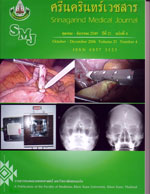Intussusception in Infancy and Children at Srinagarind Hospital
Abstract
Background : Intussusception is the most common cause of intestinal obstruction in pediatric surgery. Srinagarind hospital is a tertiary teaching hospital, in which the one-stop medical service is available. Clinical features, however, may be the limitation in diagnosis and treatment. Analysis of clinical features and therapeutic process can make us understand our situation and prevent these patients from serious complications.
Objective : To review the management of intussusception in infant and children. The clinical features, investigation and treatment are considered. To analyze the risk factors of serious bowel complications in intussusception.
Study Design : Retrospective descriptive study from medical records of pediatric intussusception patients (age below 15 years),who admitted at Srinagarind hospital during January 1991 and December 2005.
Results : Medical record of 73 pediatric patients of intussusception were analyzed. Males were more than females in the ratio 1.8 : 1, the ages varied from 1 month to 13 years. Majority (90.4%) were less than 1 year old. The median age is 6 months. The 41% of patients were from referral system. The highest annual occurrence was June and July. Commonest presentation were mucous bloody stool (67.1%), vomiting (46.5%) and abdominal pain (38.4%), which all presented in 24-hour median time. The most obvious signs were bloody mucus per rectum (65.2%), abdominal distension (63.2%) and palpable abdominal mass 56.7%. Intussusception was clearly detected by ultrasonography 94.1%. Reduction of intussusception was succeeded by barium hydrostatic enema 44.4%, in which highest success rate (55.7%) within 24-hour presentation but completely failed after 48-hour. Surgical exploration was performed in 57 patients (78.1%). The 61.6% of them were succeeded by manual reduction. For the rest 15.1% were converted to intestinal resection and primary anastomosis, due to serious bowel complications (10.9%-perforation and infarction). Over all surgical and medical complication rate was 8.22%. Period of hospital stay of successful hydrostatic reduction (median 3 days) was less than surgical treatment (median 6 days). The significant risk factors of serious bowel complications were clinical presentation more than 24 hours, and history of fever prior to admission.
Conclusions : Diagnosis of pediatric intussusception should consider the 3 commonest presentation : abdominal pain, vomiting, mucous bloody sool, and include palpable abdominal mass on examination. Ultrasonography is a useful investigation in suspicious cases. The hydrostatic barium reduction is acceptable to the uncomplicated early presentation cases. Even thought surgical rate is reduced in intussusception, surgery is still the main treatment especially in case with pathological leading point and bowel complications. All patients with high risk of serious bowel complication should be under supervision and active management.
Key words : intussusception, risk factor




